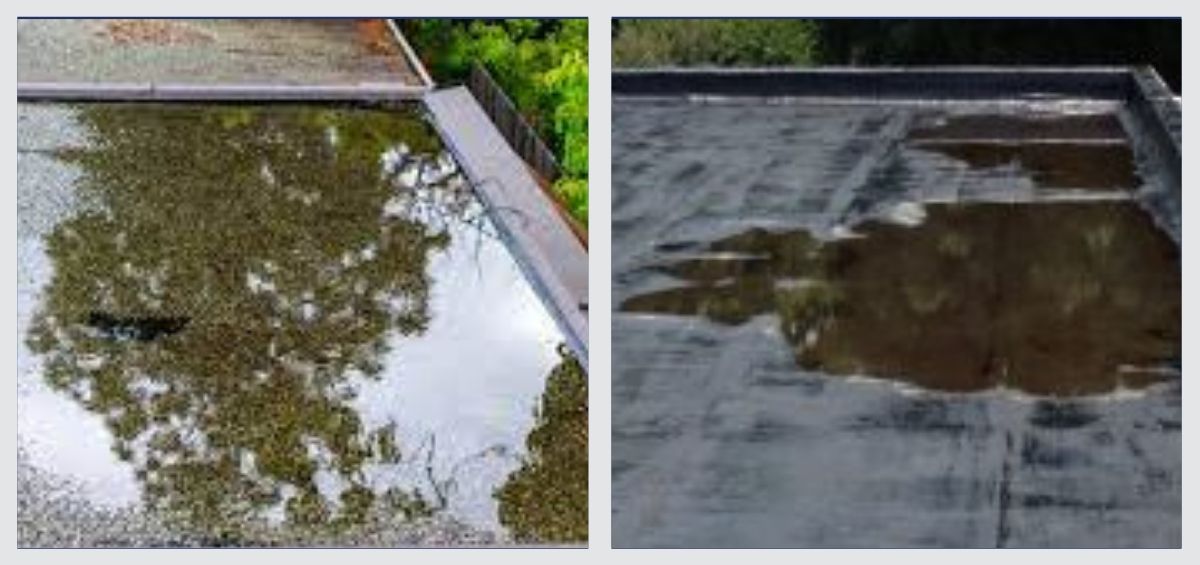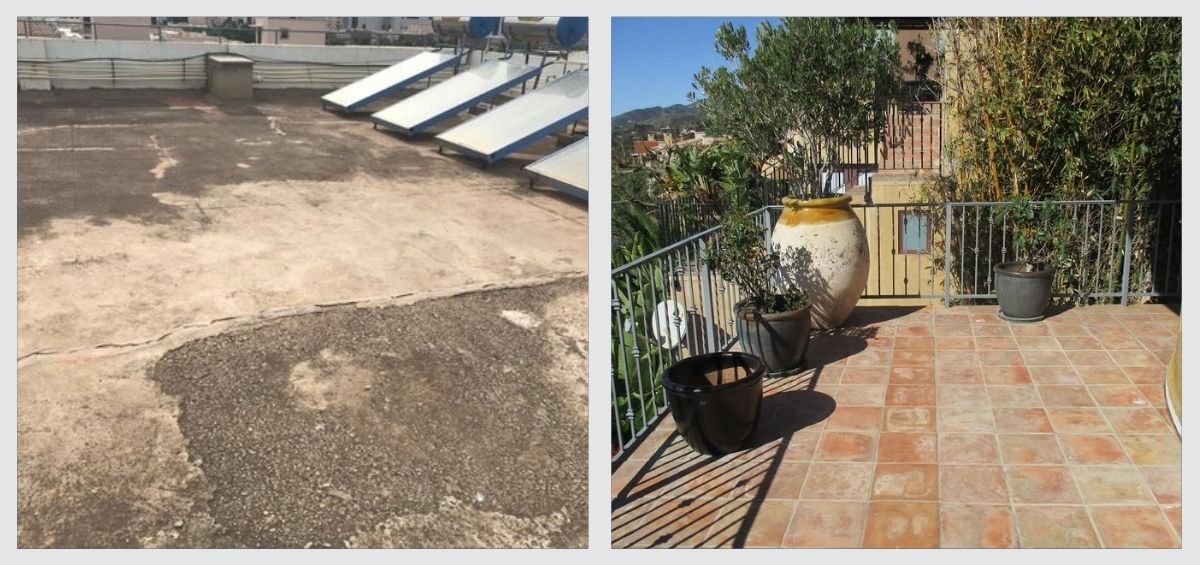Leaky Roof Overview
Roof leakage solutions- If a leak is difficult to find, enlist a helper and go up on the roof with a garden hose. If you have water stains that extend across ceilings or run down walls, the cause is probably a leaky roof. Tracking down the leak is the hard part; the roof leak repair is usually pretty easy. If you have a leaky roof, you’d better fix it immediately, even if it doesn’t bother you much or you’re getting a new roof next year. Even over a short time, small leaks can lead to big problems, such as mold, rotted framing, and sheathing, destroyed insulation, and damaged ceilings. In this article we will share with you the top Roof Leakage Solutions.

Flat Roof Leak Warning Signs
Long before a flat roof leak occurs, there are numerous warning signs you should keep an eye out for.
• Damp, dark brown patches on the ceiling indicate that moisture is seeping through your roof, which could become a major issue if not dealt with swiftly.
• If your flat-roofed garage or extension is quite old and exposed to the elements, you may notice your flat roof sagging or dipping. This is an indication that the timbers have begun to rot and will eventually give way, meaning a full flat roof replacement may be in order.
• Be on the lookout for low spots atop your flat roof, as water can pool here, placing undue stress on the structure below and slowly disintegrating the chipboard decking through exposure to excess moisture.

What Causes Flat Roof Leakage ?
There are many common causes of roof leaks. Some of these can be controlled, such as choosing the right material or installing your roof correctly. However, as time goes on, exposure to the elements, such as harsh weather or extreme temperatures, will place stress upon and eventually break down even the most well-built roof. Here are some of the most common causes of flat roof leaks:

1. Age
No matter how well they were made, or how perfectly they were installed, all roofing materials will deteriorate over time. Harsh weather conditions, extreme temperatures, sudden impacts, all of these things will eventually wear away at your flat roof until it is damaged and begins to leak. However, in recent decades, manufacturers have made great strides to advance the strength and longevity of their flat roofing products, which today far outdo those of decades past. Simply put, your flat roof may be leaking because it has reached the end of its useful life.

2. Damaged Or Deteriorated Flashing
Flashings are a key part of any flat roofing system. Their job is simple, to cover and seal any angles, seams, or joints, that would otherwise provide the perfect place for water to enter. This could be along an adjoining wall, around roof vents, and more. However, despite its impressive lifespan, lead flashing can falter, particularly when exposed to extreme temperature fluctuations. Over time, as the metal heats up and cools down, it will expand and contract, eventually revealing the edge it was meant to protect. This then, in turn, causes flat roof leaks.

3. Thermal Movement
In the second half of the twentieth century, oxidized bitumen was used as an adhesive to stick rubber roofing membranes onto flat roofs. This had many advantages, however, due to its rigidity, oxidized bitumen has a very little movement. Therefore, when temperatures change, it cannot expand or contract as necessary, leading to cracks, blisters, and splits in the membrane above, and eventually causing leaks. Many older flat roofing systems were also designed before expansion joints became widely used, which facilitate effective thermal movement to prevent membrane failure.

4. Poor Installation
Even the most well-crafted flat roofing materials will not perform correctly if they are installed poorly. Flat roofs are highly vulnerable to leaks due to their near non-existent pitch, and many weak points. Therefore, it’s vitally important that any flat roof is installed according to the manufacturer’s guidelines. If you aren’t comfortable doing the job yourself, we’d recommend finding a qualified professional roofer to install your flat roofing system. While it is more expensive, this prevents future maintenance costs and gives you peace of mind that your flat roof is nice and secure.

5. Ponding Water
While your flat roof should feature a pitch of at least 1:40, this may not be enough to completely shed water or snowfall after heavy precipitation. It can also be the case in newer homes that the structure will settle over time, causing a flat roof to shift and lose its pitch. All of this may cause water to pool in areas on your flat roof. While most flat roofing materials are designed to handle some pooling water, if the water is allowed to remain on your roof for more than 48 hours, it can begin to seep into the roof space below, deteriorating its structural integrity and eventually leading to roof leaks. Therefore, it’s imperative to drain pooling water off of your flat roof to prevent long-term damage.

6. Seams and Overlaps
One of the most common areas where flat roofs fail and spring leaks are the seams oroverlaps between different pieces of flat roofing material. This is especially common where the overlap has not been sealed correctly, as water will quickly find its way between the two layers. Seams and other joins such as overlaps are natural weak points that water can attack, and should be closely inspected at least twice per year to ensure no future problems are on the horizon. This is why we recommend EPDM membranes so highly. Installed as a single layer, there are no seams or overlaps that could cause potential leaks in your flat roof in the future.

7. Blistering
Blistering is a common issue with flat roofs. If you spot raised blisters along the surface of your flat roof, it’s a strong sign that water has gotten underneath your flat roofing material. As the water seeps down, it becomes vapourised by the higher temperatures below, this water vapour then rises, but with nowhere to escape, the pressure causes blisters. Blisters are generally caused by water ingress, where rainwater or other precipitation finds its way into a weak point of your roof. Alternatively, blisters could be caused by damp timbers or insulation, as well as condensation. Blisters are a weak point in your flat roof, and when they burst can cause significant roof leaks.

8. Delamination
Delamination occurs when the different layers of flat roofing membrane separate, becoming “delaminated” from one another. This can lead to all sorts of problems, including cracks, splits, and even blistering as water seeps into and between the two layers of material. Delamination is generally caused by poor workmanship during installation, when the layers are not heated enough to seal correctly, or when water gets in between the layers and builds up inside.

9. Detailing Around Vents
Some of the most common areas where you’ll find a flat roof leakage is from poor detailing around or damage to raised sections such as the area around roofing vents, gas lines, pipes, and more. Just like seams and joins, these present yet another weak spot for water to attack your flat roof should they not be correctly sealed. Once again, this stresses the paramount importance of finding a qualified roofer to install your flat roof if you don’t think you’re up to the task.

10. Structural Issues or Poor Design

Roof Leakage Solutions in Heavy Rain
Nothing is quite as concerning as seeing a constant drip of water coming from your ceiling. This is a possibility if you neglect to repair your roof. As water flows from your ceiling during heavy rain, there is little you can do. But to limit the water damage, here are some ways to repair flat roof leakage:
• Locate the source or location of the leak by checking the ceiling and attic to find the leak.
• Put containers under the leak to catch the water. To keep your floor as dry as possible and safe to walk on, collect the leaking water in buckets and mop around the area regularly.
• Call a commercial flat roofing repair company like Healthy Homes. Professional roof technicians will have the knowledge and equipment needed to quickly and temporarily stop the leak.
We hope this guide has been helpful to anyone currently dealing with a leaking flat roof! Healthy Homes will solve all your roof leakage solutions. If you’ve still got any more questions, please get in touch with our team. Call us on 1800-419-4647, or send an email to info@healthyhomes.co.in


